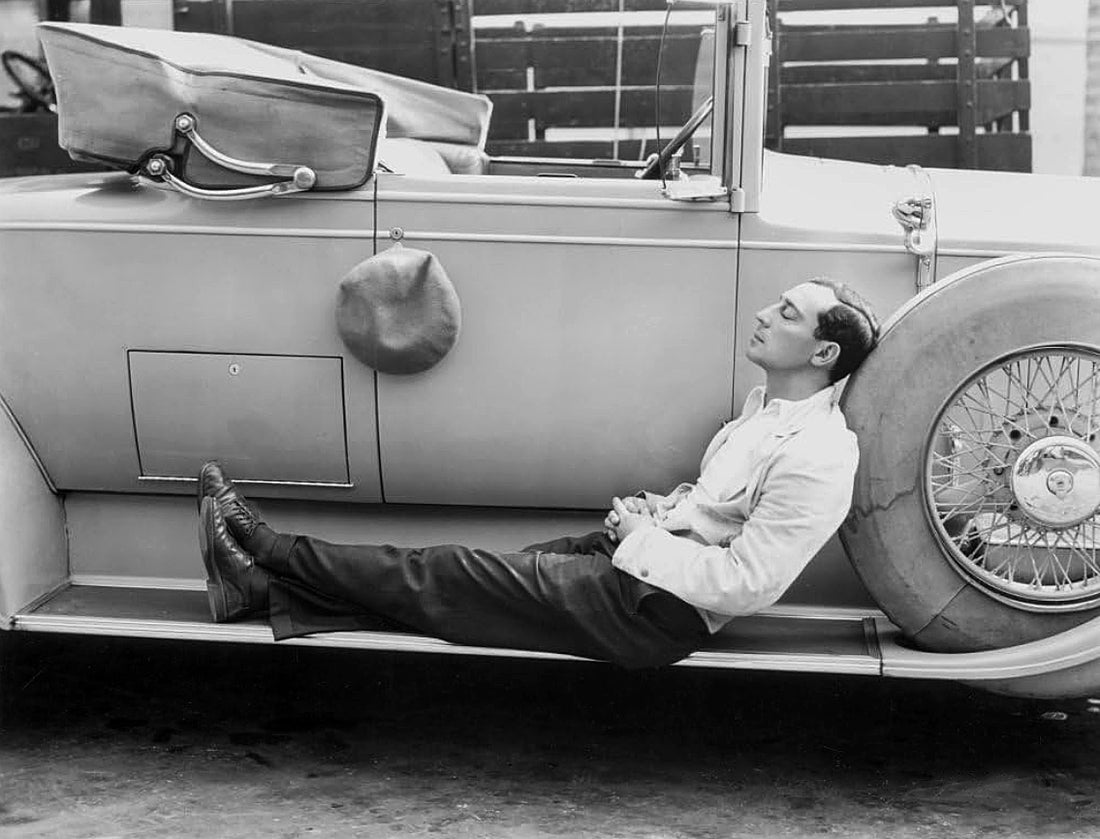Pandora Writer |
____________________
Buster Keaton, an actor, comedian, and filmmaker, was born into a family of vaudeville performers. Joseph Frank Keaton, later to be known as Buster, was born on October 4, 1895, in Piqua, Kansas. His parents, Joe and Myra Keaton, introduced their young son to the world of entertainment at an early age. According to sources, he was baptized with the nickname "Buster" by Harry Houdini after an impressive fall down a flight of stairs that left him unscathed―the moniker would come to symbolize his resilience and deadpan expression.

Keaton joined his parents on the vaudeville circuit, learning the ropes of physical comedy and honing his acrobatic skills. The family's vaudeville act, "The Three Keatons," included a unique blend of slapstick humor and impressive stunts, providing Buster with the perfect training ground for his future cinematic endeavors.
In 1917, Keaton made the leap to the silver screen, signing with Roscoe "Fatty" Arbuckle's Comique Film Corporation. Their partnership resulted in a string of successful short films.
As the silent film era progressed, Keaton's popularity soared. Known for performing his own stunts and displaying remarkable physical agility, he became a silent film icon alongside other legends like Charlie Chaplin and Harold Lloyd. Keaton's ability to create comedy through visual gags rather than dialogue, set him apart as a true master of the art form.

Keaton earned the nickname "The Great Stone Face" due to his stoic and expressionless on-screen persona. In contrast to the exaggerated expressions of many silent film actors, Keaton's poker face became his trademark.
One of his most iconic films, "The General" in 1926, showcased Keaton's prowess as both an actor and director. The film, set against the backdrop of the American Civil War, is a masterpiece of silent cinema, blending breathtaking stunts, clever physical comedy, and a compelling narrative.
The transition to feature-length films brought both challenges and triumphs for Keaton. While he faced setbacks due to the changing landscape of Hollywood and the advent of sound in cinema, Keaton continued to innovate and push the boundaries of what was possible on screen.

“Free and Easy” in 1930 was Buster Keaton's talkie debut, and his second talking picture at MGM was “Doughboys” in the same year.
Beyond his cinematic achievements, Keaton's love for baseball was notable. He organized impromptu games between takes and even integrated his passion for the sport into the hiring process, making it a unique criteria for recruiting actors. The legend goes that if an applicant answered "Yes" to being a good actor or a good baseball player, they secured a job with Keaton.
As the silent film era faded, Buster Keaton's star power experienced a decline. However, directors like Alfred Hitchcock and Orson Welles praised Keaton's contributions to cinema, recognizing his innovative techniques and timeless humor.

During the silent era of Hollywood, the leading comedians were Keaton, Charles Chaplin, and Harold Lloyd, all of whom independently produced, managed, and owned their films. In the 1920s, Keaton made the decision to sell his studio and films to MGM, in contrast to Chaplin and Lloyd, who retained ownership of their cinematic works. As a result, Chaplin and Lloyd amassed wealth, whereas Keaton faced enduring years marked by financial and personal challenges.
Keaton spent his later years performing on television and making cameo appearances in films, including a memorable appearance in "It's a Mad, Mad, Mad, Mad World" in 1963.

Keaton was married three times. His first marriage was to Natalie Talmadge in 1921, and they had two sons, Joseph and Robert. The marriage ended in divorce in 1932. Keaton then married Mae Scriven in 1933. Unfortunately, this marriage also ended in divorce in 1936. His third and final marriage was to Eleanor Norris in 1940, and they remained together until Keaton's death in 1966.
He received two Stars on the Hollywood Walk of Fame—one for Motion Pictures at 6619 Hollywood Boulevard and another for Television at 6321 Hollywood Boulevard.
Keaton passed away on February 1, 1966, at the age of 70. His battle with lung cancer marked the end of the iconic comedian's life.

Buster Keaton was a true visionary whose unparalleled talent and relentless pursuit of comedic excellence cemented his status as a comedy legend.
“Is Hollywood the cruelest city in the world? Well, it can be. New York can be like that, too. You can be a Broadway star here one night, and something happens, and then you're out--nobody knows you on the street. They forget you ever lived. It happens in Hollywood, too.” ― Buster Keaton

